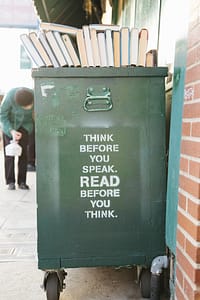So, you’ve got a killer story on your hands and want to develop your characters as much as possible. Before you go overboard, one of the key things to think about is what point of view (POV) you will write it in. There is no correct POV to use in your story. You should simply pick the one that suits your story, audience, genre, etc.
If POV is crafted correctly, the reader will be absorbed in your story… assuming your story is compelling and engaging. If done incorrectly, it will confuse the reader and take them out of the story as they may be confused by whose perspective the story is viewed from (aka head hopping).
What is point of view?
Point of view is the perspective that your story is told from – i.e., who is telling the story and how it is being told. There are three types of points of views and each can be written in present or past tense: (1) first person, (2) second person, and (3) third person.
1. First person
The story is told from a character’s point of view; usually the main character. A clear give away is if the story uses pronouns such as “I”, “my”, or “we” when describing action, events, etc. For example: “My hand trembled in the snow.” This perspective is the closest to the character and therefore minimises the “psychic distance” from the reader.
When told in present tense, story invites the reader to experience the story with the POV character. Because of this, the story needs to be told in sequence (except for flashbacks) as the character cannot jump forward in time. In contrast, first person past tense tells us what already happened, and therefore the POV character doesn’t need to tell their story in sequence and can jump back and forth in time. When a story is told in first person past tense, the reader will know the POV character isn’t killed off, so don’t write a mystery in first person past tense if you want to create uncertainty about if the character dies in the end!
A story can have multiple first-person POV however this should be indicated by scene breaks or separate chapters, otherwise reader will likely get confused about who is telling the story.
A positive is that it may be that it is the easiest POV to write because as human beings, it is natural to have thought processes in “I”, “my”, or “we”. A downside is that it limits what you can reveal to the reader as the perspective can only be shown from that one character. So, if a conversation or an event happens when the POV character isn’t present, you can’t write it from his / her perspective because POV character wouldn’t know about it. It would be similar to a party when you’re not invited. You wouldn’t know about it unless someone else told you about it. Therefore, in you would have to tease it out from others from the perspective of the POV character.
2. Second person
The story is told using the “You” pronoun. An example of this is, “You limped across the road in crutches.” Out of the 3 points of views, this is the least used and therefore a story that is written using this perspective is likely going to draw attention to itself and not necessarily in a good way.
Out of the three POVs, second person creates the most psychic distance, and is typically used when the author wants to disassociate him / herself from the story. It is also difficult to sustain for a whole story – both from an author’s and a reader’s perspective.
3. Third person
The story is told from an outside narrator who isn’t one of the characters in the story. Stories written in third person uses pronouns such as “he”, “she”, and “they”. For example, “Their hands trembled in the snow.”
Within this POV, there are 2 main categories:
a. Third person omniscient – the narrator knows everything and anything about every character at any time period. “Everything” means their thoughts, feelings, actions, smell, etc. It is like a god-like figure who knows the character’s inner most feelings even if the character themselves don’t necessarily know. Past tense is commonly used for this POV.
b. Third person limited – the narrator knows the perspective of one character, therefore the narrator only knows what that character knows. This POV is probably the best suited for multiple points of views however if you do use multiple POVs, make sure you make this clear by having scene breaks or different chapters for each POV. This is an important lesson I learnt as feedback from readers found it too confusing otherwise. Unlike first person POV, you can play around with how much distance there is to the character because there is a narrator.
A potential downside to third person POV is that it might create psychic distance as the narrator is recalling the story, instead of the character experiencing the story. However, as this POV can be written with close psychic distance and can get almost as close as first person POV, I don’t believe this downside is anything to fret about.
Which POV should you pick?
Although there are pros and cons to each POV, it’s up to you as the writer to determine which is the best for the story you’re telling and the audience you’re targeting. Notwithstanding, here are some point to consider:
1. Pick a POV that will tell your story the best. E.g., how ‘close’ do you want the reader to feel to the story. If very close, consider first person.
2. Does your chosen genre have a convention? Some genres, such as Young Adult (YA), are often told in first person. This doesn’t mean you can’t write in third person, for example, but understand that that’s not how the typical reader of YA would read the story.
3. Who has most to lose or most impacted? One way to answer this is by asking from which POV would make the most interesting scene in terms of setting up conflict and stakes. For example, a woman walks into her bedroom to find her teenage daughter taking $50 from her purse. Here, the question is whose POV would make the scene most interesting? Perhaps the teenager’s POV would be interesting as we would find out why she is taking her mother’s money. However, what if the mother walks in on her daughter gripping a knife? We might want to explore the mother’s POV because we’d naturally want to know why she is holding the knife, particularly if she has a motive. So, depending on which POV, you could make the same scene more interesting just pivoting the POV.
Regardless of which POV you write your story in, focus on writing a good story and stick to the POV convention throughout the story.







